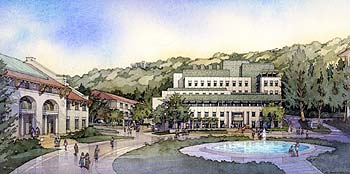 |
The planned Stanley Biosciences
and Bioengineering Facility. (ZGF Partnership architects & artist
Al Foerster) |
Gov. Davis helps break ground on new bioscience, bioengineering research building
BERKELEY – The University of California, Berkeley, broke ground Friday, May 30 for its largest research building, the Stanley Biosciences and Bioengineering Facility, designed to be the hub of biomedical and bioengineering research and teaching on campus.
| The birth of the new Stanley facility |
• A "field of dreams" for health sciences • FACTS: More about the location, design, and construction schedule |
The $162.3 million facility also will house laboratories for the College of Engineering's Department of Bioengineering and a second Cal-ISI, the Center for Information Technology Research in the Interest of Society (CITRIS).
"When construction is completed in 2006, this new facility truly will be a place where hope begins," said Chancellor Berdahl. "The work done here will lead to life-saving medicines and cutting-edge technology, while training and inspiring generations of students to carry on this work into the future."
The 285,000-square-foot building, with eight above-ground floors and three that are below ground, also represents the first phase of the campus's Health Sciences Initiative, a campus-wide program to spur innovation at the intersection of the biological and physical sciences.
Scheduled for completion in 2006, the new facility will foster interactions among scientists in fields such as structural biology, bioengineering, chemical biology, computational and theoretical biology, and magnetic imaging.
"QB3 will lead the next revolution in biomedical research," said QB3 director Graham R. Fleming, a UC Berkeley professor of chemistry. "We expect the QB3 institute to catalyze the development of fundamental biology as a quantitative predictive science. The institute provides a powerful framework to immediately connect this development to human health."
The facility will house an innovative Bio-Nano Technology Center dedicated to the fabrication of bio-MEMS and microrobotic devices on the microscopic and sub-microscopic scale. In all, the new Stanley building will contain 40 research and teaching laboratories that each can accommodate between 10 and 20 scientists, as well as classrooms and seminar facilities. The building also will be a place to train the next generation of biomedical scientists and will provide the scientific infrastructure needed to recruit future generations of outstanding faculty to the campus.
Some of the research now being pursued by UC Berkeley scientists includes:
- A DNA-sensing chip, being developed by bioengineers, that will be a quicker, easier and cheaper way to diagnose disease, detect evidence of bioterrorism, or discover new drugs.
- A new way to grow bone, with chemists using organic hydrogel polymers as scaffolds for bone re-mineralization.
- A novel drug delivery device - a microscopic syringe for painless injection of drugs through microneedles embedded in the skin. The syringe could simplify insulin injection for diabetics or ease delivery of pain medications on the battlefield.
- Probing the structure of the body's proteins to reveal how drugs work. This research by molecular biologists will assist in the development of new drugs and shed light on why some people are resistant.
- An investigation by chemists of new strategies for targeting the malaria parasite, such as interfering with the way the parasite detoxifies certain blood products.
- A new initiative to explore the potential of stem-cell biology as a way to combat devastating diseases by focusing on the basic developmental biology and mechanisms of cellular differentiation.
The state has contributed $53.1 million to the new building from Cal-ISI and seismic retrofit funds. The remainder comes from campus funds and private support.
The architectural firm Zimmer Gunsul Frasca Partnership of Portland, Ore., designed the state-of-the-art facility, which will have a grand plaza and entrance off the Hearst Mining Circle. The building's general contractor is McCarthy Building Companies Inc., headquartered in St. Louis, Mo.

